
The Ulidiidae or picture-winged flies are a large and diverse cosmopolitan family of flies (Diptera), and as in related families, most species are herbivorous or detritivorous. They are often known as picture-winged flies, along with members of other families in the superfamily Tephritoidea that have patterns of bands or spots on the wings. Some species share with the Tephritidae an unusual elongated posteroapical projection of the anal cell in the wing, but can be differentiated by the smoothly curving subcostal vein. Two species, Tetanops myopaeformis and Euxesta stigmatias, are agricultural pests.
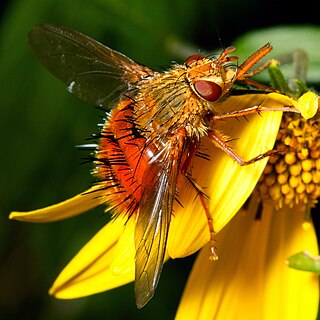
Adejeania is a genus of tachinid flies from the Americas. While most species are found in South America, A. vexatrix occurs from Mexico up to British Columbia. The genus name is an alteration of Dejeania, meaning "not Dejeania". Other tachinid genera from the same root are Eudejeania, Paradejeania and Protodejeania.
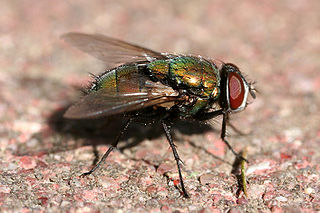
Lucilia is a genus of blow flies in the family Calliphoridae. Various species in this genus are commonly known as green bottle flies.

Eupeodes is a genus of hoverfly.
Chetogena is a genus of flies in the family Tachinidae.
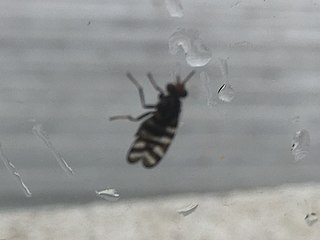
Pterotaenia is a genus of picture-winged flies in the family Ulidiidae.
Chymophila is a subgenus of the hoverfly genus Microdon. It was previously considered to be exclusively Neotropical, but is now also known from the Nearctic and Oriental realms, and one species is known from Japan. Chymophila was based on a composite type species: the holotype is a body of C. fulgens with the head of a conopid glued on.
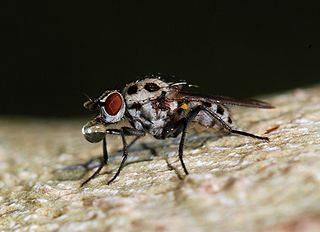
Anthomyia is a genus of flies in the family Anthomyiidae. They look rather like small houseflies, but commonly have conspicuous black-and-white patterning. This appears to be a mild form of aposematic coloration, though they do not appear to be distasteful unless they have eaten something offensive to the predator and have loaded their guts with it.

Exoristinae is a subfamily of flies in the family Tachinidae.
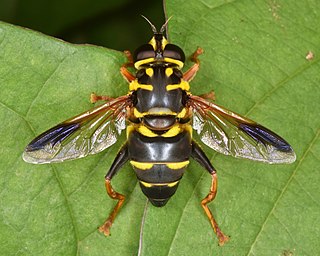
Meromacrus is a genus of 43 neotropical and nearctic flower flies or hoverflies
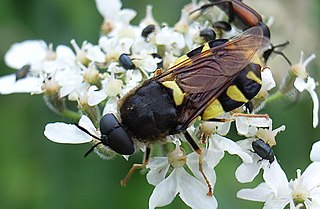
Stratiomys is a genus of soldier flies in the family Stratiomyidae. There are at least 90 described species in Stratiomys.

The Ulidiinae are a subfamily of flies in the family Ulidiidae. Like the Otitinae, most species are herbivorous or saprophagous. Most species share with the Tephritidae an unusual elongated projection of the anal cell in the wing, but can be differentiated by the smoothly curving subcostal vein. Most are dull gray to shiny brown or black flies with vein R1 setulose or, in a few cases, bare.

Tachininae is a subfamily of flies in the family Tachinidae.
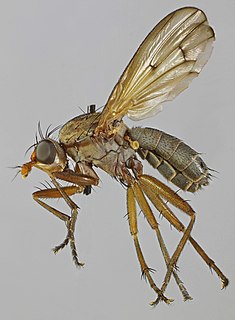
Tetanocera is a genus of marsh flies, insects in the family Sciomyzidae. There are at least 50 described species in Tetanocera.
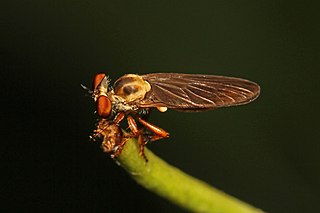
Holcocephala is a genus of robber flies in the family Asilidae. There are at least 40 described species in Holcocephala.
Lasia is a genus of small-headed flies in the family Acroceridae. There are about 19 described species in Lasia, which are distributed in the New World.

Neotanypeza is a genus of flies in the family Tanypezidae.
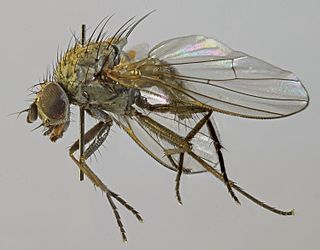
Azelia is a genus of flies belonging to the family Muscidae.














